
K2 is a mixture of leafy-looking herbs and spices that are sprayed with a psychoactive
chemical, then smoked. K2, otherwise known as "fake pot," is produced in China and
Korea. The mixture comes in several flavors: watermelon, cotton candy and pineapple
express.

Cocaine is a highly potent stimulant that is considered to be one of the greatest
drug threats to the world because of the violence associated with trafficking and
use, the physical and psychological effects associated with its use, and the costs
to society as a whole.
Wholesale cocaine traffickers purchase cocaine from importers and regional distributors
usually in kilogram or multi-kilogram allotments. This is generally the manner in
which cocaine is shipped from Colombia or other cocaine producing countries to the
United States and other consuming countries. Once the cocaine reaches its "consuming
country," other wholesalers package the powder cocaine into retail quantities (ounces
or grams) or convert the powdered cocaine into crack for retail sales.
There is great risk whether cocaine is ingested by inhalation (snorting), injection,
or smoking. It appears that compulsive cocaine use may develop even more rapidly
if the substance is smoked rather than snorted. Smoking allows extremely high doses
of cocaine to reach the brain very quickly and brings an intense and immediate high.
The injecting drug user is at risk for transmitting or acquiring HIV infection/AIDS
if needles or other injection equipment are shared.

MDMA abuse and the trafficking of MDMA is on the rise, posing serious social concerns.
Once confined to major metropolitan areas, MDMA trafficking has now expanded to
smaller communities. Teenagers and young adults continue to be the primary targets
of sophisticated crime syndicates who are supplying distribution groups with ever-increasing
amounts of MDMA tablets. As the trend to consume MDMA in tandem with alcohol and
other drugs continues, the harmful effects of the drug will increase exponentially.
MDMA (3,4-methylenedioxy-N-methylamphetamine), also referred to as Ecstasy, XTC,
Adam, and Essence, is a illegally manufactured variation of mescaline and amphetamine.
It is considered a designer drug - a substance on the drug market that is a chemical
analogue or variation of another psychoactive drug.
MDMA is marketed as a feel good drug. Devotees say it produces profoundly positive
feelings, empathy for others, elimination of anxiety, and extreme relaxation,hence
the nickname "hug drug," or "love drug." MDMA is also said to suppress the need
to eat, drink, or sleep, enabling club scene users to endure all-night and sometimes
two, or three-day parties.
MDMA is taken orally, usually in tablet or capsule form. MDMA tablets are often
"stamped" with icons or logos intended to appeal to a young audience. Its effects
last approximately four to six hours.
Tablets sold as Ecstasy are not always pure MDMA. As demand for Ecstasy has increased,
so has the appearance of Ecstasy "fakes" often containing other substances such
as amphetamine, caffeine, codeine, DXM, ephedra/ephedrine, ketamine, MDA, methamphetamine,
and PCP. When used alone, MDMA is dangerous. It is even more dangerous when used
in combination with other substances, as the physical and psychological effects
are difficult to determine or predict.

Heroin, an illegal opiate drug known on the street as smack, junk, brown sugar,
dope, horse, skunk and other names is derived from the resin of the poppy plant
which grows predominantly in southeast and southwest Asia, Mexico and now in Colombia.
It is manufactured in remote laboratories using rudimentary equipment which presses
the powder into bricks for bulk shipment to destination countries like the United
States. Smaller amounts are smuggled by couriers who swallow heroin-filled latex
balloons before boarding commercial airlines.
Pure heroin is a white powder with a bitter taste. Most illicit heroin is a powder
form which may vary in color from white to dark brown because of impurities left
from the manufacturing process or the presence of additives. Pure heroin is rarely
sold on the street. A "bag" (slang for a single dosage unit of heroin) may contain
100 mg of powder, only a small portion of which is heroin. The remainder could be
sugars, starch, powdered milk, or quinine. Traditionally the purity of heroin in
a "bag" has ranged from one to ten percent. More recently, heroin purity has ranged
from one to ninety-eight percent, with a national average of thirty-five percent.
Another form of heroin, "black tar," has also become increasingly available in the
western United States. The color and consistency of black tar heroin results from
the crude processing methods used to illicitly manufacture the substance in Mexico.
Black tar heroin may be sticky, like roofing tar or hard like coal, and its color
may vary from dark brown to black. It is often sold on the street in its tar-like
state at purities ranging from twenty to eighty percent. This heroin is most frequently
dissolved, diluted and injected.
The typical heroin user today consumes more heroin than a typical user did just
a decade ago, which is not surprising given the higher purity currently available
at the street level. Until recently, heroin in the United States almost exclusively
was injected either intravenously, subcutaneous (skin-popping), or intramuscularly.
Injection is the most practical and efficient way to administer low-purity heroin.
The availability of higher purity heroin has meant that users now can snort or smoke
the narcotic. Evidence suggests that heroin snorting is widespread or increasing
in those areas of the country where high-purity heroin is available, generally in
the northeastern United States. This method of administration may be more appealing
to new users because it eliminates both the fear of acquiring syringe-borne diseases
such as HIV/AIDS and hepatitis, and the historical stigma attached to intravenous
heroin use.
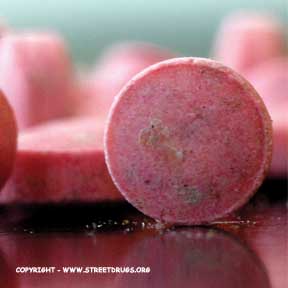
D-lysergic acid diethylamide (LSD) is the most potent hallucinogenic substance known
to man. Dosages of LSD are measured in micrograms, or millionths of a gram. By comparison,
dosages of cocaine and heroin are measured in milligrams, or thousandths of a gram.
Compared to other hallucinogenic substances, LSD is 100 times more potent than psilocybin
and psilocin and 4,000 times more potent than mescaline.
LSD is classified as a Schedule I drug in the Controlled Substances Act of 1970.
As a Schedule I drug, LSD meets the following three criteria: it is deemed to have
a high potential for abuse; it has no legitimate medical use in treatment; and,
there is a lack of accepted safety for its use under medical supervision.
The effects of LSD are unpredictable. They depend on the amount taken, the user's
personality, mood and expectations, and the surroundings in which the drug is used.
Usually, the user feels the first effects of the drug 30-90 minutes after taking
it. These effects include dilated pupils, higher body temperature, increased heart
rate and blood pressure, sweating, loss of appetite, sleeplessness, dry mouth, and
tremors. Sensations and feelings change much more dramatically than the physical
signs. The user may feel several different emotions at once or swing rapidly from
one emotion to another. Depending on the dose, the drug can produce delusions and
visual hallucinations, which can be frightening and cause panic. Users refer to
their experience with these acute adverse reactions as a "bad trip," and the effects
typically last for about twelve hours. Terrifying thoughts and feelings, fear of
insanity and death, injuries, and fatal accidents have occurred during states of
LSD intoxication. Anyone can experience a bad trip and there is no way to predict
what your own experience will be.

Marijuana is the most widely used illegal substance in the world today. Its use
is also the most controversial. With legalization efforts underway, it is important
to have the facts. Marijuana is currently legal in some form in eleven states in
the U.S. Other states are evaluating legalization. Some cities have legalized marijuana
like Brekenridge, Colorado, however, the state of Colorado nor the Federal Government
has legalized the growing or use of marijuana.
Marijuana is made from the plant cannabis sativa, a plant that grows wild (and is
also cultivated indoors and out) throughout many regions. Most of the marijuana
used in the United States comes from sources in the U.S., Mexico ("Mexican Red/Brown"),
and Canada ("BC Bud").
Marijuana consists of the buds, leaves, and resin of the cannabis plant. The stalks
and sterilized seeds are considered "hemp." The plant, cannabis sativa, contains
chemicals called "cannabinoids."
THC (delta-9-tetrhydrocannabinol) is the cannabinoid believed to be responsible
for the psychoactive effects of cannabis.
THC can be found in all parts of the cannabis plant, including hemp. This is why
hemp is regulated carefully - some hemp products such as clothing, rope, yarn, lotion
and soap are legal products because they do not cause THC to enter the human body.
"While most of the THC in cannabis plants is concentrated in the marijuana, all
parts of the plant, including hemp, have been found to contain THC. The existence
of THC in hemp is significant because THC, like marijuana, is a schedule I controlled
substance."
(Source: DEA)
"Smoking marijuana may increase the risk of cancer more than smoking tobacco. Marijuana
smoke contains 50% to 70% more carcinogenic hydrocarbons than does tobacco smoke.
It also produces high levels of an enzyme that converts certain hydrocarbons into
their carcinogenic form - levels that may accelerate the changes that ultimately
produce malignant cells." (Source: NIDA)
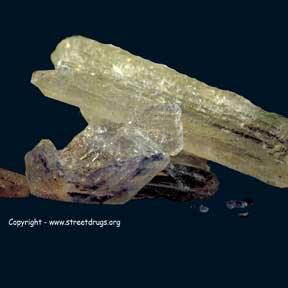
Methamphetamine is a powerful stimulant that activates certain systems in the brain.
It is closely related chemically to amphetamine, but the central nervous system
effects of methamphetamine are greater. Both drugs have some medical uses, primarily
in the treatment of obesity, but their therapeutic use is limited. The central nervous
system (CNS) actions that result from taking even small amounts of methamphetamine
include increased wakefulness, increased physical activity, decreased appetite,
increased respiration, hyperthermia, and euphoria. Other CNS effects include irritability,
insomnia, confusion, tremors, convulsions, anxiety, paranoia, and aggressiveness.
Hyperthermia and convulsions can result in death.
Illicit methamphetamine, which is almost exclusively methamphetamine hydrochloride,
is sold in powder, ice, and tablet forms. Powder methamphetamine, the most common
form available in the United States, is produced domestically and also is smuggled
into the country from Mexico. Traditionally, Asian-produced ice was almost exclusively
found in Guam, Hawaii, and parts of California; however, increased domestic production
of this form of methamphetamine has increased availability to several other areas
of the country previously untouched by exposure to ice. Methamphetamine tablets,
primarily manufactured in Burma, have been smuggled into the United States, especially
to northern California and the Los Angeles area.
Methamphetamine is also known as "speed" or "crystal" when it is swallowed or sniffed;
as "crank" when it is injected; and as "ice" or "glass" when it is smoked. Ice is
clear chunky crystal form of meth that resembles "ice."
YABA: Thai for "crazy medicine," Yaba, a methamphetamine tablet, has been appearing
in the United States. Yaba tablets are sometimes flavored (grape, orange, and vanilla):
tasting like candy, the tablets are obviously marketed to a young audience, particularly
at rave’s or parties where Ecstasy (a similar looking drug) has been well established.
The tablets are commonly reddish-orange or green, and fit inside the end of a drinking
straw. They have a variety of logos, with “WY” the most common. Methamphetamine
pills are normally ingested orally, although they can be crushed into powder and
administered.
All forms of methamphetamine are extremely dangerous and induce long-lasting, debilitating
effects.

Narcotics are drugs that alleviate physical pain, suppress coughing, alleviate diarrhea,
and induce anesthesia. Natural narcotics are derived from the Opium poppy and synthetic
narcotics are made to act like the major constituents of Opium (thebaine, morphine,
codeine). Legal, synthetic narcotics such as OxyContin (oxycodone) and Vicodin (hydrocodone)
are prescribed as pain-relievers but are often diverted for illegitimate uses. Heroin
is an illegal narcotic, derived from morphine.
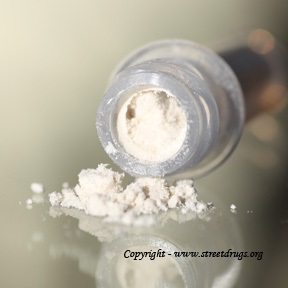
Synthetic stimulants marketed as “bath salts” are often found in a number of retail products. These synthetic stimulants are chemicals that are synthetic derivatives of cathinone, a central nervous system stimulant which is found naturally in the khat plant. Mephedrone and MDPV are two of the designer cathinones most commonly found in these “bath salt” products. Law enforcement officials believe that the chemicals contained in these products are manufactured in China and India and packaged in Eastern Europe. Many countries have banned these products.
“Bath salt” stimulant products are sold in powder form in small plastic or foil packages under various brand names. It can also be found in a tablet or capsule form. These substances are usually marketed with the warning “not intended for human consumption.” “Bath salt” effects are similar to amphetamines, cocaine, Khat, LSD and MDMA.
People who abuse these substances have reported agitation, insomnia, irritability, dizziness, depression, paranoia, delusions, suicidal thoughts, seizures and panic attacks. Users also have reported effects including an impaired perception of reality, reduced motor control and a decreased ability to think clearly. Cathinone derivatives act as central nervous system stimulants causing rapid heart rate (which may lead to heart attacks and strokes), chest pains, nosebleeds, sweating, nausea and vomiting.
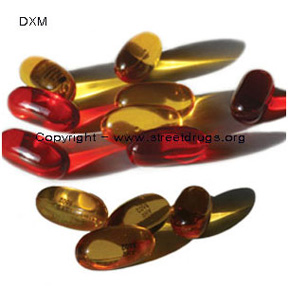
DMX is a cough-suppressing ingredient in a variety of over-the-counter cold and cough medications. Dextromethorphan, a semisynthetic narcotic, is an ingredient found in any cold medicine with "DM" or "Tuss" in the title or name. There are approximately 70 different products on the market that contain DXM.
DXM acts centrally to elevate the threshold for coughing. At the doses recommended for treating coughs (1/6 to 1/3 ounce of medication, containing 15 mg to 30 mg dextromethorphan), the drug is safe and effective. At much higher doses (4 or more ounces), dextromethorphan produces disassociative effects similar to those of PCP and ketamine.
STREET TERMS:
Orange Crush, Triple C's, C-C-C, Red Devils, Skittles, DXM, Dex, Vitamin D, Robo, Robo-trippin', Robo-dosing.
DXM EFFECTS:
Euphoria, enhanced awareness, impaired judgment, loss of coordination, dizziness, nausea, seizures, panic attacks, psychosis, brain damage, and addiction. Coma and death may result from taking cold medicines with DXM. Tolerance and physical dependence may develop with prolonged use. Withdrawal symptoms include restlessness, muscle or bone aches, insomnia, diarrhea, vomiting, and cold flashes with goose bumps (“cold turkey”).
Recent reports indicate that a powdered form of DXM is available on the Internet. Internet sites also inform young users to drink cough syrup expeditiously in order to absorb enough DXM from the drink prior to the impending incidence of vomiting which will occur as a result of the ingestion of the large volume of syrup required for intoxication.
Source: DEA Diversion Control Program, August 2001 Teens have been reported to drink three or four bottles of cough syrup in one day and take up to 20-30 tablets of Coricidin at once. There have been reported cases of overdoses that have resulted in coma and death.

Crack cocaine, a form of cocaine base, is derived from powder cocaine. Unlike the processing of freebase cocaine, converting powder cocaine into crack cocaine does not involve any flammable solvents. The powder cocaine is simply dissolved in a solution of sodium bicarbonate and water. The solution is boiled and a solid substance separates from the boiling mixture. This solid substance, crack, is removed and allowed to dry. The crack cocaine is then broken or cut into "rocks," each typically weighing from one-tenth to one-half of a gram. One gram of pure powder cocaine will convert to approximately 0.89 grams of crack cocaine. The DEA estimates that crack rocks are between 75% and 90% pure cocaine.
The effects of Crack are similar to those of Cocaine, although since Crack is smoked, additional risks exist. General effects include constricted blood vessels and increased temperature, heart rate, and blood pressure, restlessness, irritability, anxiety, and with long term use, violence and paranoia are noted. Additional risks of smoking crack include respiratory problems such as shortness of breath, chest pains, lung trauma and bleeding. As with cocaine, crack is highly addictive. Evidence shows that when cocaine and crack are smoked (as opposed to other methods), there is increased risk of compulsive cocaine-seeking behavior.
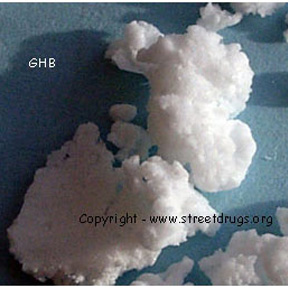
GHB (Gama Hydroxybutyric Acid) is a synthetic depressant produced in clandestine labs. While available as a prescription for sleep disorders in some other countries GHB was banned (in the U.S.) by the FDA in 1990 because of the dangers associated with its use. However, on July 17th, 2002, GHB was approved for treatment of a rare form of narcolepsy. Most of the GHB used in the U.S. is illegally manufactured within its borders. Like Rohypnol, GHB and its analogs are considered "date rape" drugs because they can be mixed with liquids (even water) and a victim wouldn't notice by smelling or looking at it. GHB, by itself, has a soapy or salty taste--but when mixed in a drink it may be difficult to detect.
Other products such as GBL and 1,4 butanediol (BD) are appearing in the illegal market as GHB substitutes. These analogs are just as dangerous and have similar effects on the body.
GHB can be made from ingredients such as GBL (gamma-butyrolactone), a solvent commonly used as a paint stripper, or butanediol (1,4-butanediol), a chemical used in the production of plastics and adhesives. Both GBL and butanediol are metabolized into GHB in the body. GHB, GBL, and butanediol (BD) are difficult to trace because they quickly leave the body and may be difficult to detect in emergency rooms and other treatment facilities. The FDA has issued warnings for both GBL and 1,4-butanediol, stating that the drugs have a potential for abuse and are a public health danger.
GHB and it's analogs are known as "G," "liquid x","caps," "scoop," "goop," "georgia home boy," and "grievous bodily harm."
GHB is a clear odorless liquid (usually mixed with alcohol) or a white powder (usually made into tablets or capsules.) GHB is snorted, smoked, or mixed into drinks. The most commonly abused form is the liquid.
On the street, it is usually sold as a liquid by the dose (a capful from a bottle or drops). In some cities, GHB is put into water guns, and users buy it by the squirt. In other instances, candy, such as a lollipop, is dipped in GHB and sold. Source: SAMHSA/CSAT, "GHB: A Club Drug to Watch."
Substance Abuse Treatment Advisory
EFFECTS OF USE:
The effects of GHB vary each time a person uses it and it affects each person differently. Initial effects include euphoria and relaxation. Within 15 minutes nausea, dizziness, drowsiness, visual disturbances, respiratory distress, amnesia, seizures, and coma are possible. It is difficult to predict a person's reaction to GHB-- because GHB is produced in clandestine labs, the purity and strength of doses vary. Coma, poisoning and death resulting from ingestion of GHB have been well documented. As of November 2000, DEA documented 71 GHB-related deaths.
Coma and seizures can occur following abuse of GHB and, when combined with methamphetamine, there appears to be an increased risk of seizure. Combining use with other drugs such as alcohol can result in nausea and difficulty breathing. GHB may also produce withdrawal effects, including insomnia, anxiety, tremors, and sweating. Because of concern about Rohypnol, GHB, and other similarly abused sedative-hypnotics, Congress passed the "Drug-Induced Rape Prevention and Punishment Act of 1996" in October 1996. This legislation increased Federal penalties for use of any controlled substance to aid in sexual assault.
Source: "Rohypnol and GHB," NIDA InfoFacts, #13556

Marketed as a dissociative general anesthetic for human and veterinary use, the only known source of ketamine is via diversion of pharmaceutical products. Recent press reports indicate that a significant number of veterinary clinics are being robbed specifically for their ketamine stock. DEA reporting indicates that a major source of ketamine in the United States is product diverted from pharmacies in Mexico. Ketamine liquid can be injected, applied to smokable material, or consumed in drinks. The powdered form is made by allowing the solvent to evaporate, leaving a white or slightly off-white powder that, once pulverized, looks similar to cocaine. The powder can be put into drinks, smoked, or dissolved and then injected.
Ketamine produces physical effects similar to PCP, with the visual effects of LSD. Users report that it is better than PCP or LSD because the trip lasts an hour or less. Low doses of the drug produce an experience called “K-Land,” a mellow, colorful “wonder world.” Higher doses produce an effect referred to as “K-Hole,” an “out of body,” or “near-death” experience. Due to its dissociative effect, it is reportedly used as a date-rape drug.
Source: DEA, "Club Drugs: An Update,"
Ketamine is similar molecularly to phencyclidine (PCP) and thus creates similar effects including numbness, loss of coordination, sense of invulnerability, muscle rigidity, aggressive/violent behavior, slurred or blocked speech, exaggerated sense of strength, and a blank stare. Since ketamine is an anesthetic, it stops the user from feeling pain, which could lead the user to inadvertently cause injury to himself/herself. Ketamine may relieve tension and anxiety, is purported to be a sexual stimulant, and intensifies colors and sounds.
The effects of a ketamine 'high' usually last an hour but they can last for 4-6 hours, and 24-48 hours are generally required before the user will feel completely "normal" again. Effects of chronic use of ketamine may take from several months to two years to wear off completely. Low doses (25-100mg) produce psychedelic effects quickly. Large doses can produce vomiting and convulsions and may lead to oxygen starvation to the brain and muscles; one gram can cause death. Flashbacks may even occur one year after use. Long-term effects include tolerance and possible physical and/or psychological dependence.

A number of Schedule I hallucinogenic substances are classified chemically as tryptamines. Most of these are found in nature but many, if not all, can be produced synthetically. Psilocybin (O-phosphoryl-4-hydroxy-N, N-ethyltryptamine) and psilocyn (4-hydroxy-N, N-dimethyltryptamine) are obtained from certain mushrooms indigenous to tropical and subtropical regions of South America, Mexico, and the United States. As pure chemicals at doses of 10 to 20 mg, these hallucinogens produce muscle relaxation, dilation of pupils, vivid visual and auditory distortions, and emotional disturbances. However, the effects produced by consuming preparations of dried or brewed mushrooms are far less predictable and largely depend on the particular mushrooms used and the age and preservation of the extract. There are many species of "magic" mushrooms that contain varying amounts of these tryptamines, as well as uncertain amounts of other chemicals. As a consequence, the hallucinogenic activity, as well as the extent of toxicity produced by various plant samples, are often unknown.
DIMETHYLTRYPTAMIN (DMT) has a long history of use and is found in a variety of plants and seeds. It can also be produced synthetically. It is ineffective when taken orally, unless combined with another drug that inhibits its metabolism. Generally it is sniffed, smoked, or injected. The effective hallucinogenic dose in humans is about 50 to 100 mg and lasts for about 45 to 60 minutes. Because the effects last only about an hour; the experience has been referred to as a "businessman’s trip."
A number of other hallucinogens have very similar structures and properties to those of DMT. Diethyltryptamine (DET), for example, is an analogue of DMT and produces the same pharmacological effects but is somewhat less potent than DMT.
Alpha-ethyltryptamine (AET) is another tryptamine hallucinogen added to the list of Schedule I hallucinogens in 1994. Bufotenine (5-hydroxy-N-N-dimethyltryptamine) is a Schedule I substance found in certain mushrooms, seeds, and skin glands of Bufo toads. In general, most bufotenine preparations from natural sources are extremely toxic. N,N-Diisopropyl-5-methoxytryptamine (referred to as Foxy-Methoxy) is an orally active tryptamine recently encountered in the United States.
(Source: DEA)
Alpha-methyltryptamine (AMT), known as "spirals," was designated a Schedule I drug by the DEA in April of 2003. 5-methoxy-alpha-methyltryptamine (5-MeO-AMT) is also a tryptamine. Other common names for 5-MeO-AMT are "alpha-O", "alpha" and "O-DMS."
EFFECTS: Users of tryptamines typically experience a multitude of effects. These effects include hallucinations, euphoria, dilated pupils, empathy, visual and auditory disturbances/distortions, “feelings of love,” and emotional distress. Some users may experience nausea, vomiting, and diarrhea. Tryptamines, like Foxy and AMT, are very dose dependent, which means that the doubling of a moderate dose could result in effects similar to LSD. The duration of effects from 20 mg of AMT usually last between 12 and 24 hours, while the effects from 6 to 10 mg of Foxy reportedly last from 3 to 6 hours
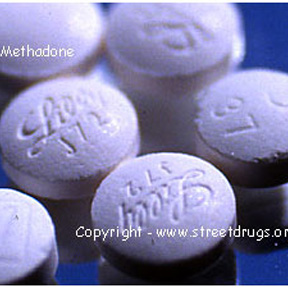
German scientists synthesized methadone during World War II because of a shortage of morphine. Although chemically unlike morphine or heroin, methadone produces many of the same effects. Introduced into the United States in 1947 as an analgesic (Dolophinel), it is primarily used today for the treatment of narcotic addiction. It is available in oral solutions, tablets, and injectable Schedule II formulations, and is almost as effective when administered orally as it is by injection. Methadone's effects can last up to 24 hours, thereby permitting once-a-day oral administration in heroin detoxification and maintenance programs. High-dose methadone can block the effects of heroin, thereby discouraging the continued use of heroin by addicts under treatment with methadone. Chronic administration of methadone results in the development of tolerance and dependence. The withdrawal syndrome develops more slowly and is less severe but more prolonged than that associated with heroin withdrawal. Ironically, methadone used to control narcotic addiction is frequently encountered on the illicit market and has been associated with a number of overdose deaths.

Rohypnol (flunitrazepam), most commonly known as a date-rape drug, continues to be abused among teenagers and young adults, usually at raves and nightclubs. The drug remains readily available, mainly through pharmaceutical operators located in Mexico, especially Tijuana.
Rohypnol is marketed by Hoffman-La Roche Inc., and is legally sold in Latin America and Europe as a short-term treatment for insomnia, and as a preanesthetic medication. One of the significant effects of the drug is anterograde amnesia, a factor that strongly contributed to its inclusion in the Drug-Induced Rape Prevention and Punishment Act of 1996. Anterograde amnesia is a condition in which events that occurred while under the influence of the drug are forgotten.
Rohypnol is available as a .5-milligram and 1-milligram oblong tablet, as well as a 1-milligramper milliliter injectable solution. Hoffman-La Roche phased out the 2-milligram dose tablet from 1996 to 1997, and is currently phasing out the round, white 1-milligram tablet. The licit market for the drug is currently supplied with a 1-milligram dose in an olive green, oblong tablet, imprinted with the number 542. The new tablet includes a dye that, according to Hoffman-La Roche, will be visible if it is slipped into a drink. Reports indicate that Rohypnol is often sold for between $2 and $5 per dosage unit, although it may sell for from $10 to $30 per dosage unit.
In addition to the chemically induced amnesia, Rohypnol often causes decreased blood pressure, drowsiness, visual disturbances, dizziness, confusion, gastrointestinal disturbances, and urinary retention. Users of the drug report effects similar to intoxication, yet claim that they wake up the next morning without a hangover. Adding to the popularity of the drug is the perception that the drug cannot be detected in a urinalysis. While the drug can be detected (2-milligram doses can be detected within 72 hours of ingestion), it does break down very quickly, and many commercial toxicological screens do not detect flunitrazepam. In sexual assault cases, forensic laboratories need to screen for the flunitrazepam metabolite, 7-amino-flunitrazepam, using gas chromatography and/or mass spectrometry.
Source: DEA Drug Intelligence Brief, "Club Drugs: An Update
STREET NAMES: Roofies, Rophies, Roche, Forget-me Pill, Circles, Mexican Valium, Rib, Roach-2, Roopies, Rope, Ropies, Ruffies, and Roaches.

25I-NBOMe is a hallucinogenic drug that is a derivative of the substituted phenethylamine psychedelic 2C-I. It is a new substance, and little is known about its behavioral and pharmacological risks. It is referred to as 25I, 25C, NBOME, GNOME, Dime and DOB.
Users compare the effects of 25I-NBOMe to LSD. Like LSD, it is measured in micrograms and is often distributed on “tabs.” These tabs are often mistaken for LSD. It is used sublingually and buccally; users also report snorting, smoking, and inhaling the drug.
Effects can last four to twelve hours and are subject to how the drug is taken and what dosage is used. Users report euphoria, hallucinations, and mental and physical stimulation. They also report nausea, difficulty focusing, confusion, vasoconstriction, panic and paranoia, fainting, and out of control thinking.
STREET NAMES: 25I, 25C, NBOME, GNOME, Dime and DOB.
For more information regarding drugs and their effects, please visit
www.dea.gov.